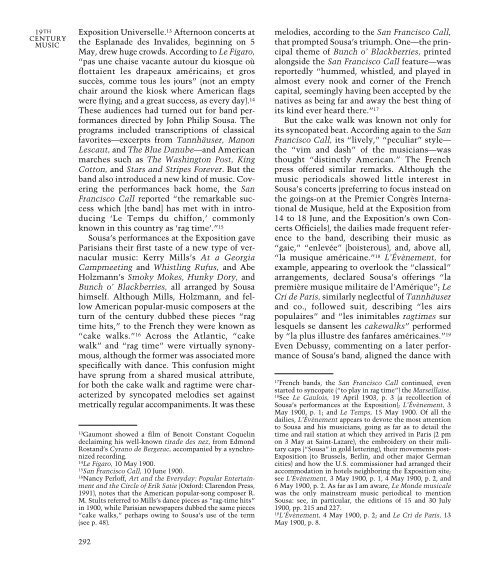Parisian Cake Walks.pdf - ResearchSpace@Auckland
Parisian Cake Walks.pdf - ResearchSpace@Auckland
Parisian Cake Walks.pdf - ResearchSpace@Auckland
You also want an ePaper? Increase the reach of your titles
YUMPU automatically turns print PDFs into web optimized ePapers that Google loves.
19TH<br />
CENTURY<br />
MUSIC<br />
Exposition Universelle. 13 Afternoon concerts at<br />
the Esplanade des Invalides, beginning on 5<br />
May, drew huge crowds. According to Le Figaro,<br />
“pas une chaise vacante autour du kiosque où<br />
flottaient les drapeaux américains; et gros<br />
succès, comme tous les jours” (not an empty<br />
chair around the kiosk where American flags<br />
were flying; and a great success, as every day). 14<br />
These audiences had turned out for band performances<br />
directed by John Philip Sousa. The<br />
programs included transcriptions of classical<br />
favorites—excerpts from Tannhäuser, Manon<br />
Lescaut, and The Blue Danube—and American<br />
marches such as The Washington Post, King<br />
Cotton, and Stars and Stripes Forever. But the<br />
band also introduced a new kind of music. Covering<br />
the performances back home, the San<br />
Francisco Call reported “the remarkable success<br />
which [the band] has met with in introducing<br />
‘Le Temps du chiffon,’ commonly<br />
known in this country as ‘rag time’.” 15<br />
Sousa’s performances at the Exposition gave<br />
<strong>Parisian</strong>s their first taste of a new type of vernacular<br />
music: Kerry Mills’s At a Georgia<br />
Campmeeting and Whistling Rufus, and Abe<br />
Holzmann’s Smoky Mokes, Hunky Dory, and<br />
Bunch o’ Blackberries, all arranged by Sousa<br />
himself. Although Mills, Holzmann, and fellow<br />
American popular-music composers at the<br />
turn of the century dubbed these pieces “rag<br />
time hits,” to the French they were known as<br />
“cake walks.” 16 Across the Atlantic, “cake<br />
walk” and “rag time” were virtually synonymous,<br />
although the former was associated more<br />
specifically with dance. This confusion might<br />
have sprung from a shared musical attribute,<br />
for both the cake walk and ragtime were characterized<br />
by syncopated melodies set against<br />
metrically regular accompaniments. It was these<br />
13 Gaumont showed a film of Benoit Constant Coquelin<br />
declaiming his well-known tirade des nez, from Edmond<br />
Rostand’s Cyrano de Bergerac, accompanied by a synchronized<br />
recording.<br />
14 Le Figaro, 10 May 1900.<br />
15 San Francisco Call, 10 June 1900.<br />
16 Nancy Perloff, Art and the Everyday: Popular Entertainment<br />
and the Circle of Erik Satie (Oxford: Clarendon Press,<br />
1991), notes that the American popular-song composer R.<br />
M. Stults referred to Mills’s dance pieces as “rag-time hits”<br />
in 1900, while <strong>Parisian</strong> newspapers dubbed the same pieces<br />
“cake walks,” perhaps owing to Sousa’s use of the term<br />
(see p. 48).<br />
292<br />
melodies, according to the San Francisco Call,<br />
that prompted Sousa’s triumph. One—the principal<br />
theme of Bunch o’ Blackberries, printed<br />
alongside the San Francisco Call feature—was<br />
reportedly “hummed, whistled, and played in<br />
almost every nook and corner of the French<br />
capital, seemingly having been accepted by the<br />
natives as being far and away the best thing of<br />
its kind ever heard there.” 17<br />
But the cake walk was known not only for<br />
its syncopated beat. According again to the San<br />
Francisco Call, its “lively,” “peculiar” style—<br />
the “vim and dash” of the musicians—was<br />
thought “distinctly American.” The French<br />
press offered similar remarks. Although the<br />
music periodicals showed little interest in<br />
Sousa’s concerts (preferring to focus instead on<br />
the goings-on at the Premier Congrès International<br />
de Musique, held at the Exposition from<br />
14 to 18 June, and the Exposition’s own Concerts<br />
Officiels), the dailies made frequent reference<br />
to the band, describing their music as<br />
“gaie,” “enlevée” (boisterous), and, above all,<br />
“la musique américaine.” 18 L’Évènement, for<br />
example, appearing to overlook the “classical”<br />
arrangements, declared Sousa’s offerings “la<br />
première musique militaire de l’Amérique”; Le<br />
Cri de Paris, similarly neglectful of Tannhäuser<br />
and co., followed suit, describing “les airs<br />
populaires” and “les inimitables ragtimes sur<br />
lesquels se dansent les cakewalks” performed<br />
by “la plus illustre des fanfares américaines.” 19<br />
Even Debussy, commenting on a later performance<br />
of Sousa’s band, aligned the dance with<br />
17 French bands, the San Francisco Call continued, even<br />
started to syncopate (“to play in rag time”) the Marseillaise.<br />
18 See Le Gaulois, 19 April 1903, p. 3 (a recollection of<br />
Sousa’s performances at the Exposition); L’Évènement, 3<br />
May 1900, p. 1; and Le Temps, 15 May 1900. Of all the<br />
dailies, L’Évènement appears to devote the most attention<br />
to Sousa and his musicians, going as far as to detail the<br />
time and rail station at which they arrived in Paris (2 pm<br />
on 3 May at Saint-Lazare), the embroidery on their military<br />
caps (“Sousa” in gold lettering), their movements post-<br />
Exposition (to Brussels, Berlin, and other major German<br />
cities) and how the U.S. commissioner had arranged their<br />
accommodation in hotels neighboring the Exposition site;<br />
see L’Évènement, 3 May 1900, p. 1, 4 May 1900, p. 2, and<br />
6 May 1900, p. 2. As far as I am aware, Le Monde musicale<br />
was the only mainstream music periodical to mention<br />
Sousa: see, in particular, the editions of 15 and 30 July<br />
1900, pp. 215 and 227.<br />
19 L’Évènement, 4 May 1900, p. 2; and Le Cri de Paris, 13<br />
May 1900, p. 8.















